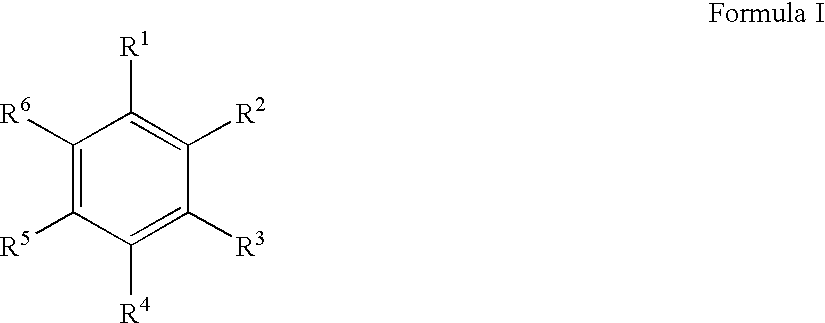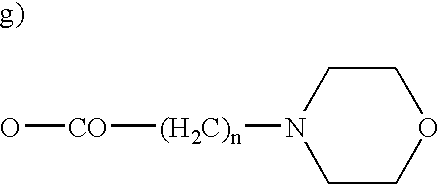Treatment of HIV and diseases of immune dysregulation
a technology of immune dysregulation and treatment, applied in the direction of cardiovascular disorders, group 5/15 element organic compounds, drug compositions, etc., can solve the problems of patients' failure to comply, virus subverts and progressively destroys the very system on which it is relied, and patients' attempts have met mixed results, so as to achieve the effect of attenuating the dysfunction of the immune system
- Summary
- Abstract
- Description
- Claims
- Application Information
AI Technical Summary
Benefits of technology
Problems solved by technology
Method used
Image
Examples
example 1
[0261] This example demonstrates the synthesis of a compound according to Formula I. A mixture of 2,6-dimethoxyphenol (73.4 g, 0.48 mole), 2,6-dimethyl-2-heptanol (69.0 g, 0.48 mole) and methanesulfonic acid (95 mL) was stirred at 50° C. for 3 h and then at room temperature overnight. The mixture was poured over ice-water (600 mL) with stirring. The mixture was extracted with CH2Cl2 (2×200 mL). The extracts were washed with water, saturated aqueous NaHCO3, saturated aqueous sodium chloride solution and dried over anhydrous Na2SO4. The solution was concentrated under reduced pressure to obtain the product as an oil (130 g, 96%). Analysis of this substance (MS (NAB) m / z 281 (MH)′; 3H NMR (CDCl3) 50.80 (d, 6H), 1.0-1.1 (m, 4H), 1.27 (s, 6H), 1.40-1.60 (m, 3H), 3.89 (s, 6H), 5.36 (s, 1H), 6.54 (s, 2H)) revealed it to be 4-(1,1,5-trimethylhexyl)-2,6-dimethoxy phenol:
example 2
[0262] This example demonstrates the synthesis of a compound according to Formula I. A solution of crude 4-(1,1,5-trimethylhexyl)-4,6, dimethoxyphenol from Example 1 (130 g, 0.46 mole) in dry CCl4 (100 mL) was cooled in ice-bath and diethyl phosphite (70 mL, 0.54 mole) was added. To the stirred mixture triethylamine (75 mL, 0.54 mole) was added drop-wise at such a rate as to maintain the temperature of the reaction mixture below 10° C. The reaction mixture was stirred in the ice-bath for 2 h and at room temperature overnight. The mixture was then diluted with CH2Cl2 (200 mL), washed with water, 4N aqueous NaOH (100 mL), 1N aqueous HCl (125 mL), water and saturated aqueous sodium chloride solution. The extracts were dried over anhydrous Na2SO4 and concentrated under reduced pressure. The crude product was purified by chromatography over a column of silica using cyclohexane:EtOAc (7:1 to 3:1 gradient) as the eluent to obtain 103 g (54%) of the product as a colorless waxy oil. Analysis...
example 3
[0263] This example demonstrates the synthesis of a compound according to Formula I. A solution of 4-(1,1,5-trimethylhexyl)-2,6-dimethoxyphenyl diethyl phosphate from Example 2 (82 g, 0.197 mole) in Et20 (175 mL) and THE (35 mL) was added slowly to liquid ammonia (450 mL) contained in a 3-neck vessel fitted with mechanical stirrer, thermometer, dry ice condenser and a pressure equalizing addition funnel while adding small freshly cut pieces of lithium wire (2.8 g, 0.40 g-atom) at such a rate as to maintain a blue color. The reaction mixture was stirred further for an hour and then quenched by the addition of saturated aqueous NH4Cl (22 mL). Ether (220 mL) was added and the ammonia was allowed to evaporate overnight. The residue was treated with water (220 mL). The layers were separated and the ether layer was washed with 4N NaOH (200 mL), water (2×200 mL) and saturated aqueous sodium chloride solution. The organic extracts were dried (MgSO4) and concentrated under reduced pressure. ...
PUM
| Property | Measurement | Unit |
|---|---|---|
| Molar density | aaaaa | aaaaa |
| Molar density | aaaaa | aaaaa |
| Molar density | aaaaa | aaaaa |
Abstract
Description
Claims
Application Information
 Login to View More
Login to View More - R&D
- Intellectual Property
- Life Sciences
- Materials
- Tech Scout
- Unparalleled Data Quality
- Higher Quality Content
- 60% Fewer Hallucinations
Browse by: Latest US Patents, China's latest patents, Technical Efficacy Thesaurus, Application Domain, Technology Topic, Popular Technical Reports.
© 2025 PatSnap. All rights reserved.Legal|Privacy policy|Modern Slavery Act Transparency Statement|Sitemap|About US| Contact US: help@patsnap.com



